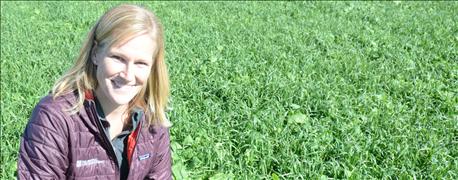April 1, 2016

Can you use cover crops in a corn-soybean rotation in the Northern Plains? In North Dakota? No way, you might say. The season is just too short after harvest to be able to get cover crops established before it freezes.
But Abby Wick, North Dakota State University Extension soil health specialist, says it can -- and is -- being done. She asnwers some questions about how she and her team and several farmers she is working with get cover crops established in corn and soybeans:

Abby Wick, NDSU Extension soils health specialist, tells how to get cover crops established in corn and soybeans in the Northern Plains.
What's working?
We’ve had the most success getting cover crop mixes established in corn by either flying on the seed when the corn is tasseling or interseeding when the corn is at the V5 stage of growth. Many of those mixes include winter wheat or cereal rye plus radish and turnip. For soybean, I think the best fit is having the cereal rye on the ground the fall before going into beans. We are always trying to fit a cover crop in after the cash crop, but for beans, a good fit is before. Some guys have tried cover crops into soybean on 30-inch rows before leaf drop and have had some success. A Wahpeton, N.D., farmer drilled cereal rye following soybean harvest and had great success last year. But it was also a good year for cover crops. They literally followed the combine with the air seeder to get the cover crop in the ground. After soybean seems like the toughest place to include cover crops in a rotation.
What establishment practices are you experimenting with this coming year?
We will be looking at interseeding corn and sunflower with some kind of highboy unit. We'll do this on our plots in Traill and Sargent counties. On Grand Forks and Richland county plots, we may experiment with interseeding something into soybean before leaf drop. Using some kind of spreader box mounted on a sprayer so that we can follow those tracks. We will again use full season cover crops on saline ground for remediation and follow small grains with a cover crop.
What tips or advice do you have for farmers who are want to use cover crops in a corn-soybean rotation?
The first thing I would tell them is that it's tough. Their best bet is to put a small grain back in rotation to give them the window to include cover crops. But if that's not an option, I would recommend they fly on cereal rye into their corn. The key with cover crops is that it may not work the first year because of weather conditions, but don't give up and keep trying. Inner seeders are becoming more and more popular with manufacturers - or if a farmers already side-dresses his corn, can he put some kind of spreader box or hoses that can drop the cover crop seed on the ground when they are side dressing? Farmers are the innovators, so I know they will figure out a way with the equipment they have. It's just the timing and the mixes that they may have questions on.
Learn more at the NDSU Soil Health website, www.ndsu.edu/soilhealth.
You May Also Like




